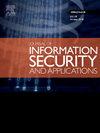Improving the security of asymmetric secret sharing scheme and its new applications
IF 3.8
2区 计算机科学
Q2 COMPUTER SCIENCE, INFORMATION SYSTEMS
Journal of Information Security and Applications
Pub Date : 2025-06-12
DOI:10.1016/j.jisa.2025.104098
引用次数: 0
Abstract
In conventional threshold secret sharing, secret information or input can be recovered by collecting shares from servers, regardless of the honesty of the player. However, in asymmetric secret sharing, the input remains unrecoverable even if the attacker collects all shares from all data servers. Asymmetric secret sharing provides an asymmetric structure in which only an honest/authorized player can regain the input by combining shares from the data servers with pseudorandom numbers that are generated by the authorized player to complete the required shares. Nevertheless, the asymmetric secret sharing scheme does not rely on information-theoretic security but rather on computational security. In this study, we first demonstrate the vulnerability of the conventional computationally secure asymmetric secret sharing scheme by presenting possible attacks on the scheme. We then show that by introducing true random numbers, an asymmetric secret sharing scheme with information-theoretic security can be achieved under certain conditions. We also identify and provide a detailed discussion of the conditions required to achieve information-theoretic security. However, the required conditions result in a reduction in storage efficiency on the server. We implemented our proposed method and evaluated its efficiency under these conditions, and showed that the execution time remains within the acceptable range and has a minimal effect on practical use. Moreover, we show that the proposed method can realize new applications that are not possible with conventional secret sharing schemes, such as secure data management that does not leak secret information even if the entire dataset in the cloud containing the shares is compromised, and communication, including IoT communication.
改进非对称秘密共享方案的安全性及其新应用
在传统的(k,n)阈值秘密共享中,秘密信息或输入可以通过从n个服务器收集k份来恢复,而不管玩家是否诚实。然而,在非对称秘密共享中,即使攻击者收集了来自所有数据服务器的所有共享,输入仍然是不可恢复的。非对称秘密共享提供了一种非对称结构,在这种结构中,只有诚实/授权的玩家才能通过将来自数据服务器的份额与授权玩家生成的伪随机数相结合来重新获得输入,以完成所需的k个份额。然而,非对称秘密共享方案不依赖于信息论安全,而是依赖于计算安全。在这项研究中,我们首先展示了传统的计算安全的非对称秘密共享方案的脆弱性,提出了可能的攻击方案。通过引入真随机数,可以在一定条件下实现具有信息论安全性的非对称秘密共享方案。我们还确定并详细讨论了实现信息论安全性所需的条件。但是,所要求的条件会降低服务器上的存储效率。我们在这些条件下实现了我们提出的方法,并评估了它的效率,并表明执行时间仍然在可接受的范围内,并且对实际使用的影响很小。此外,我们表明,所提出的方法可以实现传统秘密共享方案无法实现的新应用,例如即使包含共享的云中的整个数据集遭到破坏也不会泄露秘密信息的安全数据管理,以及通信,包括物联网通信。
本文章由计算机程序翻译,如有差异,请以英文原文为准。
求助全文
约1分钟内获得全文
求助全文
来源期刊

Journal of Information Security and Applications
Computer Science-Computer Networks and Communications
CiteScore
10.90
自引率
5.40%
发文量
206
审稿时长
56 days
期刊介绍:
Journal of Information Security and Applications (JISA) focuses on the original research and practice-driven applications with relevance to information security and applications. JISA provides a common linkage between a vibrant scientific and research community and industry professionals by offering a clear view on modern problems and challenges in information security, as well as identifying promising scientific and "best-practice" solutions. JISA issues offer a balance between original research work and innovative industrial approaches by internationally renowned information security experts and researchers.
 求助内容:
求助内容: 应助结果提醒方式:
应助结果提醒方式:


